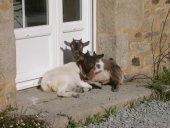posted 8 years ago
I've noticed, while perusing the critter section, that there is a lack of discussion regarding working animals. There is not a "working animal" option as a new topic available. The exceptions are the discussions of livestock guardian dogs and the horse, mule and donkey option.
Working animals provide biological solutions to many common management challenges. Using critters for work requires far less fossil fuel energy input than mechanical or electronic "fixes".
Here at TerraFlora, we have a working Brown Swiss ox named Hercules. He is immense, very strong and very handsome. Compared to our small tractor he is slower, quieter and smells better. Hercules' food grows here. The tractor's does not.
Some context. We are working 65 acres of second and third growth coniferous forest in Northeastern Washington State. The land is convoluted and hilly with a steep creek drainage through it. Recently the USDA has changed our hardiness zone to 6b. Unfortunately, much warmer winters mean that many of the native trees are dying. Diseases and bugs are killing ALL the lodgepole pine in the area. The larch is also suffering and will also be gone in 15 - 20 years according to the University of Idaho. Our challenge as permaculturists is to take this crisis of rapid phyto-migration head-on and turn it to our advantage. Besides the obvious solution of making some lumber from the dying and doomed trees, what are our other strategies for dealing with this enormous amount of bio-mass and the associated immediate fire risk? How can we effectively store the carbon and increase fertility? What the hell will grow here in 20 - 30 - 50 years? And the list of questions goes on. We refer to our design and management approach to this project as Sylvanculture.
This is where Hercules comes into the frame. He is here to work in the woods. He moves loads of firewood, logs, poles etc. I would like to try him at small scale earthworks, but will probably have to make equipment- and there are only so many hours in the day. Herk is my first ox and came to us fully trained. When Hercules moved in we had been researching oxen. I was about to buy a pair of Brown Swiss calves to raise and train. For those who find the idea of a draft animal intimidating, I recommend oxen over horses. A novice can train an ox. Not so with a horse. Hercules works singly because his partner died a few years ago. His gear, therefore, is a tad more complex than a pair of oxen require. A pair of oxen can pull damn near anything with just a yoke and a chain.
We also use Hercules grazing with the sheep to reduce fire risk in the woods. He can reach far above the deer and sheep ( Herky tapes at 2,700 lbs. and is 6'4" at the top of his shoulders) to get brush which has grown too high for the smaller critters to eat. Like the sheep, he takes down the lower brush as well. Converting brush and fines into manure instead of fuel for wildfire, is part of the plan.
We have also used goats for this purpose in the past. We used them to dramatically improve forage for wildlife and reduce fire risk on a ridge top in Montana. Our goats were not dairy animals, they were pack animals. We took them hiking often. They wore small crossbuck pack saddles. After my wife was in a bad wreck we had to stop hiking and let the goats die off without replacing them. This spring I am buying a couple of young bottle fed wethers which I will be packing when they are old enough. We won't be hiking for recreation though. Their job will be to pack my chainsaw, tools, gas and oil as we work thinning. I'm old enough that using them to pack my tools will allow me to work longer.
We are also going to get a tending dog. This seems like an obvious way to use intensive rotational grazing without the moving of fences or having numerous paddocks. This is certainly true on our steep wooded ground. The dog brings the sheep to the area being grazed, keeps them within the boundary markers, protects them and then at the end of the day brings them back to the pen. Do any other permaculturists use tending dogs? Herding, tending and driving dogs are the three categories of general herding dogs. Tending dogs were used in Europe to keep the sheep from getting into crops without fences, protecting the sheep and moving them.
I don't know if this topic of working animals is of interest to other permaculturists out there. We'll see.

 2
2












 In all seriousness though, IF I did have livestock power, it would be oxen. Few people realize this, but in Maine where I live, horses for pioneering families were rare, the ox was the stead that pulled the plow, pulled wood, and if need be; put meat on the table.
In all seriousness though, IF I did have livestock power, it would be oxen. Few people realize this, but in Maine where I live, horses for pioneering families were rare, the ox was the stead that pulled the plow, pulled wood, and if need be; put meat on the table.























